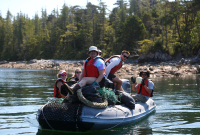Support strong Canadian climate journalism for 2025
A whistleblower who played a key role raising the alarm of the health risks posed by the oilsands has a new concern — this time in his own backyard.
Dr. John O’Connor is campaigning with fellow concerned citizens against the use of the insecticide rotenone to rid Edmonton waters of invasive goldfish that have been breeding in a number of lakes in Edmonton subdivisions.
O’Connor worked as a physician for Indigenous communities downstream of the oilsands and drew public attention to what he noted was a high prevalence of unusual cancers.
“The risks to human health are well known, yet we are being lied to!” O’Connor said in an email about rotenone and the messaging behind its use in his neighbourhood.
Rotenone, the main component of the insecticide noxfish, is a World Health Organization class II toxin linked to Parkinson’s disease and developmental neurotoxicity. Sales of rotenone have been banned in the United Kingdom since 2009.
EPCOR, Edmonton’s utility company, notified residents in May 2024 that it would be using the insecticide in West Edmonton’s Lake Guinevere, O’Connor said.
In a statement to Canada’s National Observer, EPCOR said it needs to prevent the spread of invasive species to the North Saskatchewan River, or they could overwhelm native species and destroy ecosystems.
There are two options for successful removal of invasive goldfish: rotenone or draining and maintaining a dry storm pond for a winter season, Ryan Fournier, press secretary to Rebecca Shulz, Minister of the Environment and Protected Areas for the province, told Canada’s National Observer in a statement.
“Rotenone is the least disruptive and most successful eradication method,” Fournier added.
In flyers, EPCOR has told residents that rotenone is not harmful to humans, but to expect to see workers in hazmat suits on the day of application. EPCOR also advised residents to pull back their belongings from the lake and noted odours would be present.
That’s when the red flags were raised for O’Connor. He and other concerned residents dug into the research and found that exposure to the pesticide carried dangers to health.
When the group disputed EPCOR’s claims that the insecticide was harmless, the utility’s response was that it did not want to alarm residents, O’Connor said.
O’Connor and others began doorknocking to speak about the flyer and set up a table on the lake’s trail to inform local residents about the risks of rotenone and gather signatures on a petition against its use. Within a couple of days, the petition had 300 signees and counting.
“People were angry and enraged… people were not told [of the risks],” he said.
Beyond the lake, EPCOR has plans to use the insecticide in man-made stormwater ponds.
In a statement to Canada’s National Observer, EPCOR said it is mandated by Alberta Environment and Protected Areas (AEPA) to eradicate invasive species from stormwater management facilities.
The utility maintains that the best way to eradicate goldfish is through chemical treatment using rotenone, and that the chemical “does not affect wildlife, humans or pets when applied as directed.”
The chemical breaks down naturally in water with no long-term adverse effects, and is also diluted and generally applied below the surface of water to reduce risks to surrounding areas and individuals, the utility explained.
However, O’Connor says his advocacy group feels “betrayed, saddened and angry at the utter lack of transparency,” he said in an email to Canada’s National Observer.
In the most recent flyer to residents, distributed Tuesday, the same claims regarding the pesticide’s “harmlessness” were repeated to residents, O’Connor said.
O’Connor pointed to more than 300 more ponds around Edmonton that will be potentially targeted for rotenone application — with many residents unknowingly exposed.
Matteo Cimellaro / Canada’s National Observer / Local Journalism Initiative






Comments
Two points here:
-There's a vast difference between the in vitro toxicity of a product and the risk of exposure. In the case of rote none, risk of exposure is very small.
-Control of invasive species is important. The use of rotenone for this purpose is not new. Is there any evidence from previous use that rotenone used in this way poses a risk to humans. Rather than both-sidsing the issue, could the reporter not have looked into that? You have to balance the risk posed to wildlife from an invasive species with risk to humans from rotenone. The latter seems very very small. Do better, National Observer.
Thanks. It's not the first time the CNO was so positive towards a source that commenters have to cut down the credulity a little. I'm afraid this actually has me questioning the doctor's work at the tar sands.
I'm sorry, but you really need to re-think your question!! No more studies need to be done to PROVE that Dr. O'Connor's claims about the devastating effects of tar sands activities on his patients is REAL!!
If you can't see through the veil of brainwashing that oil comanies like Epcor are so well practised in doing, then you need to return to kindergarten!!
Thank you!
That's a salient point, as much as it throws a wrench into one's sense of doing the right thing with respect to protecting ecological systems.
Case in point: Japanese knotweed, the Godzilla of invasive species. If allowed to spread, it can lift or crack house foundations and break bridge abutments. It spreads like wildfire through deep underground roots that can grow 5 metres a year, and can re-establish far away by carrying tiny plant tissue fragments on one's shoes, gardening tools or vehicle tires, defeating every attempt at physically removing it. It completely subsumes native plants, especially in wetlands. Biological insect control is possible, but importing bugs that eat the plant can also present invasive challenges, and it takes years of experimentation to approve them.
The only control that is currently effective is Round Up, a nasty chemical concoction that contains 2-4D. RU is systemic, absorbed by the leaves and carried down to the stems and roots. Patches of knotweed need to be securely fenced off and signed before finely targetted spraying. Several applications of the herbicide may be required, and it could take up to three years to be completely rid of it at partucular sites. Once the patch is dead, the plants and surrounding soil have to be excavated with machinery that, preferably, rolls through a construction site tire wash to remove any left over live plant fragments. The material and the tire wash effluent is then transported to large incineration facilities or landfills that have special deep bury sections (6m+) capped with a thick layer of hard clay.
Some cities with Integrated Pest Management policies where Round Up was previously banned have had to revisit the policy after great damage has occurred to natuve and domestic landscapes and issue special permits to use it under strict isolation conditions on public land.
Private property is another story. Yep, it's a time bomb until such time biological controls have been tested and be found to work.
Until then, maintaining environmental principals without knowledge of the possible consequences in some cases can have disastrous results.